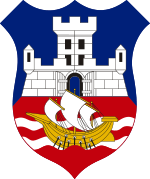- Coat of arms of Belgrade
-
Belgrade 
Versions 
Shield of the coats of arms of BelgradeDetails Orders Karađorđe's Star with Swords (1939)
Légion d'honneur (1920)
Czechoslovak War Cross (1925)
National Hero (1974)Belgrade has small, medium, and large coats of arms.
Contents
History
The small coat of arms was sketched by Đorđe Andrejević Kun in 1931, and was officially adopted the following year. In July 2003, medium and large coats of arms were adopted. They were designed by the Serbian Heraldry Society "White Eagle" . The basic (small) coat of arms is intended for wide public usage, and is the only one that may be used for commercial purposes. The medium coat of arms is used by the city administration, its organizations, and at significant events. The large coat of arms is used for presenting the city of Belgrade, and only the top city officials may use it. Occasionally, with the permission of officials, citizens may use it. The coat of arms has recently been changed to include name of the city and URL of its official website.
Small coat of arms
The small coat of arms has the shape of a shield, and consists of the three Serbian national colors (red, blue, white). The blue sky symbolizes hope and faith in a better future. The red colour of the ground is a symbol of the suffering of the Serbian people in the struggle for freedom. The rivers (Sava and Danube) symbolise the strength of Belgrade, and they are white according to the rules of heraldry. The white walls and towers are marks of a white city (Београд / Beograd is Serbian for "White City"). The walls represent a city of trade, the tower and open gate represent an open market and hospitality. The ship, a Roman trireme refers to the antiquity of the city.
Medium coat of arms
The medium coat of arms is the same as the small one, but has a golden mural crown placed above the shield. The crown has five visible merlons, and a diadem with five gems (rubies, sapphires, emeralds). According to the standards of Serbian Heraldry Society, this wall crown with five indents belongs only to the capital city, and the diadem with jewels belongs to the historical capitals.
Large coat of arms
The large coat of arms consists of a silver (white) bicephalic (two-headed) eagle, armed gold, with golden legs and tongue. The eagle is a symbol of the Serbian state, and is consistent with the coat of arms of Serbia. On the eagle's chest are the coat of arms of Belgrade, which emphasis the status of capital, and above the eagle's heads is the wall crown of the medium coat of arms. Underneath the eagle are two oak branches, which represent civic virtues, and over the point where they cross is the first known coat of Belgrade, which represents the heraldic history of the city. The sword and the olive branch on the large coat of arms represent readiness to fight in war, and to cooperate in peace. Over the oak branches are decorations given to Belgrade, in their natural colours, and with appropriate ribbons. They stand for the glorious past and merits of the citizens of Belgrade. The medals are:
- Order of the Karađorđe's Star with Swords, given to the Belgrade on May 18, 1939. The order was founded in four grades King Petar I of Serbia on January 1, 1904.
- Légion d'honneur, founded on May 19, 1802, by Napoleon Bonaparte, and is given as fifth grade and is the highest decoration of France. It was awarded to Belgrade in 1920, by Franchet d'Espèrey, French marshal, and honorary duke of Serbian army. Only four cities outside France have received this medal (it is not given to cities anymore): Belgrade, Liege, Luxembourg, and Stalingrad (because of the famous Battle of Stalingrad). Belgrade is awarded with Legion of Honour because of the glorious defense of Belgrade in World War I (1915), when Major Dragutin Gavrilović gave his famous speech to the defenders of Belgrade.
- Czechoslovak War Cross, given to Belgrade on October 8, 1925, founded by the Czechoslovakian government. It was given for courage, and valour in fighting the enemy in WWI.
- Order of the National Hero, given to Belgrade on October 20, 1974 (on the occasion of the thirtieth anniversary of Belgrade's liberation in World War II)
References
- Belgrade Coat of Arms and Flag, City of Belgrade
Categories:- 1932 introductions
- Serbian coats of arms
- Culture in Belgrade
- History of Belgrade
- Coats of arms of cities
Wikimedia Foundation. 2010.
